stonewall50
New member
Well maybe quick and steady wins the race? I am talking about one of the most important aspects of concealed carry. The draw. I got advice from a gang unit LEO on firearms training and how to proceed with this specific task. I will share the information with everyone here.
I unload my gun and make sure that I am in a safe area. I go through the entire process of the draw SLOWLY. I did this since the day I purchased my handgun (the day I turned 21). I put on my standard every day clothes and for 20 minutes a day I would perfect the shirt lift. I then took the next step of getting my hand on the gun. Next step was getting the gun out of the holster and moving it to the first position I would need(2 hands and controlling my weapon). I didn't even bother extending my arms during these practice sessions. I did this slow and steady step by step process for at least a year and a half. I did it so often that there were days I would catch myself going through the motion with no gun, needless to say it started a few odd conversations. Anyway.
I can now say that, while I am NOT Quick Draw McGraw, I am proficient at the draw. Arm extension is not an issue(something I worked on during live fire), and getting a gun out of the holster is a nice and smoothe process. I still have the occasional hang up in practice since I speed up sometimes, but I always go back and do the same process of shirt rise and draw from IWB.
If anyone has any suggestions to help me improve my draw I would love tips, but I will always go back to the slow and steady process.
I unload my gun and make sure that I am in a safe area. I go through the entire process of the draw SLOWLY. I did this since the day I purchased my handgun (the day I turned 21). I put on my standard every day clothes and for 20 minutes a day I would perfect the shirt lift. I then took the next step of getting my hand on the gun. Next step was getting the gun out of the holster and moving it to the first position I would need(2 hands and controlling my weapon). I didn't even bother extending my arms during these practice sessions. I did this slow and steady step by step process for at least a year and a half. I did it so often that there were days I would catch myself going through the motion with no gun, needless to say it started a few odd conversations. Anyway.
I can now say that, while I am NOT Quick Draw McGraw, I am proficient at the draw. Arm extension is not an issue(something I worked on during live fire), and getting a gun out of the holster is a nice and smoothe process. I still have the occasional hang up in practice since I speed up sometimes, but I always go back and do the same process of shirt rise and draw from IWB.
If anyone has any suggestions to help me improve my draw I would love tips, but I will always go back to the slow and steady process.



